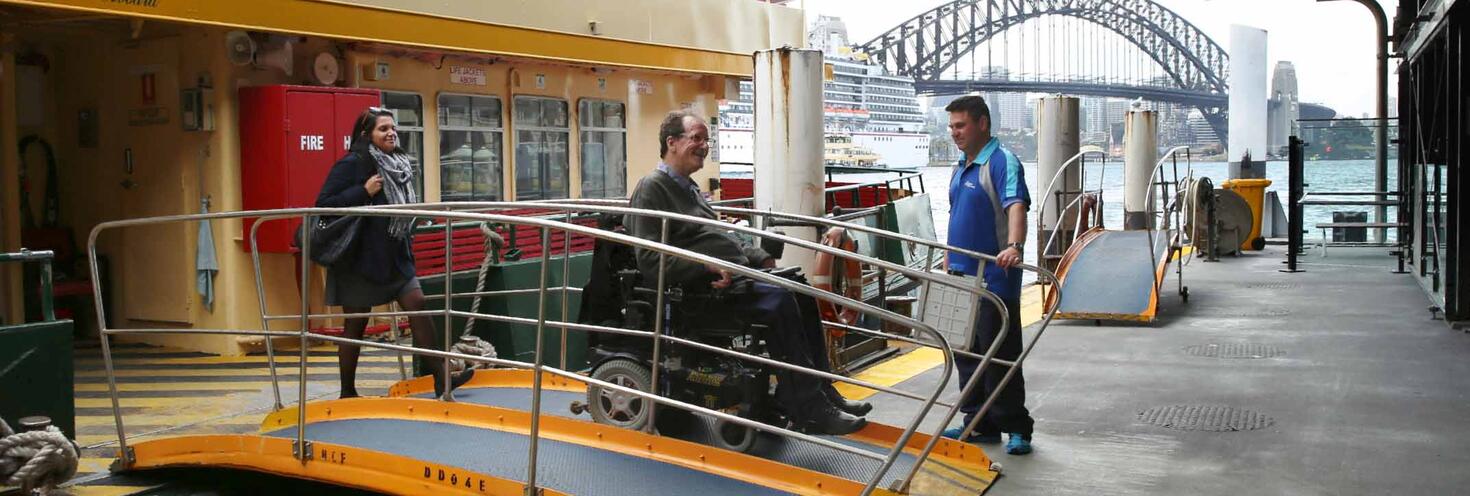Mobility aid specifications

When using a mobility aid on public transport in NSW, it must comply with certain dimensions, manoeuvrability and stability specifications.
The Disability Standards for Accessible Public Transport make some basic assumptions about mobility aids and gaining access to public transport. If your mobility aid does not meet these criteria, you may not be able to use it on public transport..
These specifications apply to manual and motorized wheelchairs, scooters, walking frames, and prams when using accessible services.
Please note that not all trains, buses, ferries, or coaches are accessible with a mobility device. You can use the Trip Planner to plan an accessible trip, and see accessible services indicated by the wheelchair symbol in the search results. See more tips on planning an accessible trip. Sydney Metro is a fully accessible railway.
To be able to safely use boarding ramps and fit within wheelchair allocated spaces on metro, train, coach, bus, Manly ferry and light rail services, your mobility aid must be no more than:
- Length: 1300mm
- Width: 800mm
- Weight: 300kg, including occupant, personal items and anyone required to assist on the boarding ramp
For ferries (except Manly ferries) and wharves, the dimensions are:
- Length: 1300mm
- Width: 740mm
- Weight: 300kg, applies to wharves
For Regional trains, the dimensions are:
- Length: 1300mm
- Width: 700mm
- Weight: 300kg
Your mobility aid must have an effective brake system and must be able to withstand:
- acceleration, braking and cornering on metro, train, coach, bus and light rail services
- acceleration, deceleration and pitching on ferries
On Regional coaches, mobility aids must be anchored and secured with approved tie down points fitted on the coach.
Mobility aids must also comply with regulations governing the carriage of batteries on public transport.
To be able to safely use public transport services and facilities, your mobility aid must be able to turn 180 degrees within an area of 2070mm by 1540mm.
Bus
When travelling on accessible buses, your mobility aid will need to be able to safely board and manoeuvre into the travel position required, which is usually facing towards the back of the bus.
It must also be able to:
- cross a horizontal gap up to 40mm wide
- mount a bump up to 12mm
- cross grating gaps up to 13mm wide and 15mm long
- negotiate a 1 in 14 ramp unassisted (or 1 in 8 when the ramp is less than 1520mm)
When waiting for public transport:
- Position yourself in the boarding zone or in a safe spot where the driver or the crew can see you as they approach the stop.
- Make sure you are a safe distance away from the edge of the platform, the gutter or the wharf.
- Park sideways rather than facing the edge, so you can see your service approaching.
- Always apply the brakes when you are stationary while waiting or when on board public transport.
- Give way to pedestrians and travel no faster than walking pace around stations, stops and wharves.
Regional coach
If you are travelling with a mobility aid and do not want to remain in the mobility aid for the entire journey, you can request an additional seat at no cost. Wheelchairs will be stored under the coach for safety purposes.
If you are unable to transfer to a seat unassisted, you must remain in the mobility aid for the entire journey. You must have an approved seat belt fitted, or be able to have a seat belt (supplied by the coach operator) fitted and anchored to the floor mounting points.
Please note that toilets onboard regional coaches are not wheelchair accessible. Scheduled rest breaks are provided for journeys over 5 hours.
Scooters are considered small vehicles. If your scooter is a required mobility aid, it will only be carried on public transport if it is safe and fits the specifications.
It must be able to be driven onto the service and manoeuvred to fit wholly within the allocated wheelchair space under its own power.
Restrictions
- Petrol run scooters are not permitted on public transport in any circumstances in accordance with the Passenger Transport Regulation 2007.
- Three-wheeled scooters are not permitted on ferries, wharves or buses.
|
Type of scooter |
Trains and stations |
Buses and stops |
Ferries and wharves |
Light rail and stops |
|---|---|---|---|---|
|
Three-wheeled scooters allowed |
Yes |
Not on buses |
No |
Yes |
|
Electric scooters allowed |
Yes |
Yes |
Yes |
Yes |